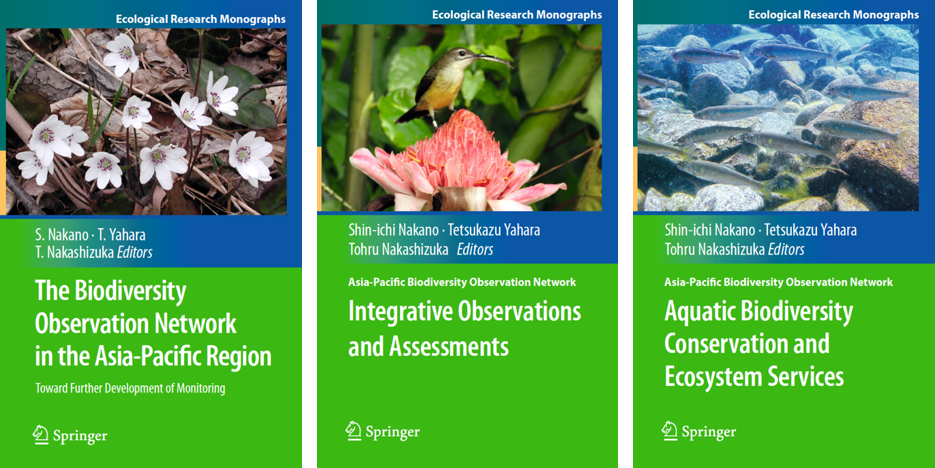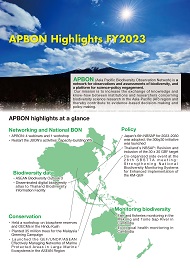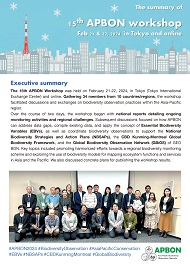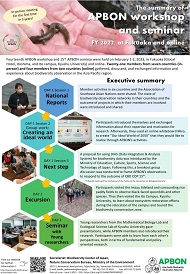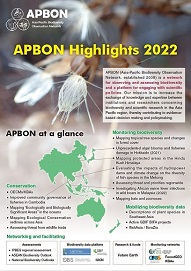
TOP > 生物多様性センターの国際協力 > APBON > About us > Publications

Publications
APBON Highlights FY2023
Please click the picture below to download the APBON Highlights FY2023. [PDF:2.9MB]
The summary of 15th APBON workshop
Please click the picture below to download the The summary of 15th APBON workshop. [PDF:2.29MB]
The summary of APBON workshop and seminar: FY 2022, at Fukuoka and online
Please click the picture below to download the summary of APBON workshop and seminar FY2022. (It will automatically connect to the External link to the NIES Repository)
APBON Highlights 2022
Please click the picture below to download the APBON activity Highlights 2022. (It will automatically connect to the External link to the NIES Repository)
References
1.Muraoka H. (2022) Phenology of photosynthesis in a deciduous broadleaf forest: implications for the carbon cycle in a changing environment. In: (eds. F. Li, Y. Awaya, K. Kageyama and Y. Wei) River Basin Environment: Evaluation, management and conservation. Springer https://doi.org/10.1007/978-981-19-4070-5_1 2. Shin et al. Ecological Research. accepted. Review: Monitoring of land cover changes and plant phenology by remote-sensing in East Asia. https://researchmap.jp/shin_nagai/published_papers/40305367 3. Amit et al. Remote sens.(2021). A Novel Approach for Forest Fragmentation Susceptibility Mapping and Assessment: A Case Study from the Indian Himalayan Region. https://doi.org/10.3390/rs13204090 4. http://www.kurs50008.sakura.ne.jp/sarawak/en/ 5. Chaudhary et al. Conservation Science and Practice. (2022). Protected areas in the Hindu Kush Himalaya: a regional assessment of status, distribution and gaps. https://doi.org/10.1111/csp2.12793 6. Suyama et al. Ecological Research (2022) Complementary combination of multiplex high-throughput DNA sequencing for molecular phylogeny. 37:171?181. https://doi.org/10.1111/1440-1703.12270 7. ffishAsia https://ffish.asia/?lang=e floraZia https://florazia.com/ Kano Y (2022) Bio-photogrammetry: digitally archiving coloured 3D morphology data of creatures and associated challenges. Research Ideas and Outcomes 8: e86985. https://doi.org/10.3897/rio.8.e86985 8. Asia Pacific Workshop on Healthy and Resilient Ocean https://www.jamstec.go.jp/bioenv/e/un-ocean-decade-labo/ 9. MBON Networking Fridays. https://www.aircentre.org/netfridays-marine-biodiversity-03/ 10. Consideration of Genetic Structure in the Ecologically or Biologically Significant Marine Areas Criteria: A Review of Convention on Biological Diversity Regional Workshops and A Case Study of Coral Reef Conservation Planning https://www.frontiersin.org/articles/10.3389/fmars.2022.823009/full 11. Tahara et al. PeerJ in press.(2022) Species level mapping of a seagrass bed using an unmanned aerial vehicle and deep learning technique https://peerj.com/articles/14017/ 12. Application of eDNA metabarcoding in faunal biodiversity assessment of Indo-Pacific mangroves vulnerable to climate change. https://www.the-easia.org/jrp/projects/project_84.html 13. Sudo et al. Frontiers in Marine Science 8: 637722 (2021) Distribution, temporal change and conservation status of tropical seagrass beds in Southeast Asia: DOI: 10.3389/fmars.2021.637722 14. Quiros et al. Frontiers in Marine Science 8: 671753 (2021) Blue carbon ecosystem services through a vulnerability lens: opportunities to reduce social vulnerability in fishing communities DOI: 10.3389/fmars.2021.671753
APBON related papers
The Asia‐Pacific Biodiversity Observation Network: 10‐year achievements and new strategies to 2030
https://doi.org/10.1111/1440-1703.12212
This paper, written by 34 members of the Asia-Pacific Biodiversity Observation Network (APBON) from 10 countries, reviews APBON's activities over the past 10 years and how APBON has built networks, facilitated communication for knowledge sharing, and built the capacity of researchers and stakeholders through workshops and publications. Our new strategic plan for 2030 aims at filling the biodiversity data and knowledge gaps, promotion of establishing a national BON and implementing interdisciplinary research projects. By promoting biodiversity monitoring and scientific research, and facilitating dialogue with scientists and policymakers, APBON will contribute to the conservation and sustainable use of biodiversity across the AP region.
APBON books
1. The Biodiversity Observation Network in the Asia-Pacific Region: Toward Further Development of Monitoring. S. Nakano, T. Yahara, T. Nakashizuka (eds.), Springer 2012
(https://www.springer.com/gp/book/9784431540311)
2. Asia-Pacific Biodiversity Observation Network: Integrative Observations and Assessments. S. Nakano, T. Yahara, T. Nakashizuka (eds.), Springer 2014
(https://www.springer.com/gp/book/9784431547822)
3. Asia-Pacific Biodiversity Observation Network: Aquatic Biodiversity Conservation and Ecosystem Services. S. Nakano, T. Yahara, T. Nakashizuka (eds.), Springer, 2016
(https://www.springer.com/gp/book/9789811007781)
